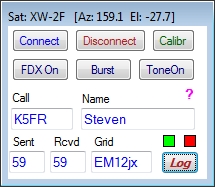Difference between revisions of "Sat"
From DDUtilV3
(→DDUtil Runtime Window) |
(→Notes) |
||
| Line 49: | Line 49: | ||
==Notes== | ==Notes== | ||
| − | + | # The satellite feature is only available for Flex 6K (6500/6700) users. | |
| + | # Control explanations are available by hovering the cursor over the control of interest. | ||
Revision as of 08:14, 5 June 2016
Contents
Purpose
The purpose of this feature is to allow users the ability to automate control of LEO (Low Earth Orbiting) satellites while connected to a F6K radio (6500 or 6700).
Requirements
Software
- SatPC32 is required to obtain satellite name, frequency data and rotor tracking ability.
- QRZ.com XML subscription if QSO partner data retrieval is desired.
- DXLab's DXKeeper logging program if auto logging is desired.
Hardware
- 2m & 70cm transverters.
Setup
SatPC32
Configure in the normal manner except omit Cat control for the radio as DDUtil will take care of that.
SSDR
DDUtil Setup
Open the Other tab in DDUtil and go to the Satellite group.
- Select the virtual serial port for SatPC32.
- Enter the QRZ.com ID and Password if you want to be able to lookup call signs.
- Enter UHF and VHF macros if used.
- Select whether you want to use DXKeeper or an ADIF file for logging QSOs.
GUI Controls
Operation
DDUtil Runtime Window
Controls
- Connect/Disconnect → Connect or Disconnect from the SatPC32 program.
- Calibr → Displays the calibration form.
- FDX On → Toggles the SSDR FDX (Full Duplex) feature On/Off.
- Burst → Sends a two (2) second 74.4 Hz tone to satellite SO-50 to activate its timer.
- Tone On → Press this button to work around a SSDR profile bug where the CTCSS TX is not persisted for FM satellites.
- Call → Enter call of QSO partner and press the Tab key to lookup call details. Note: requires a QRZ.com XML Data subscription account.
- Double-clicking the call window will erase call, name and grid info.
- Name → Name of QSO partner.
- Double-clicking the name window will erase name.
- Sent/Rcvd → Sent and Received signal reports (program defaults to 59).
- Grid → Grid square of QSO partner.
- Double-clicking the grid window will erase grid.
- Green Button → Displays the ADIF log file.
- Red Button → Erases the ADIF file (use with caution).
- Log → Enters the QSO contact data to either DXKeeper or the ADIF file depending on the log selection setting in DDUtil's Other tab.
Notes
- The satellite feature is only available for Flex 6K (6500/6700) users.
- Control explanations are available by hovering the cursor over the control of interest.

